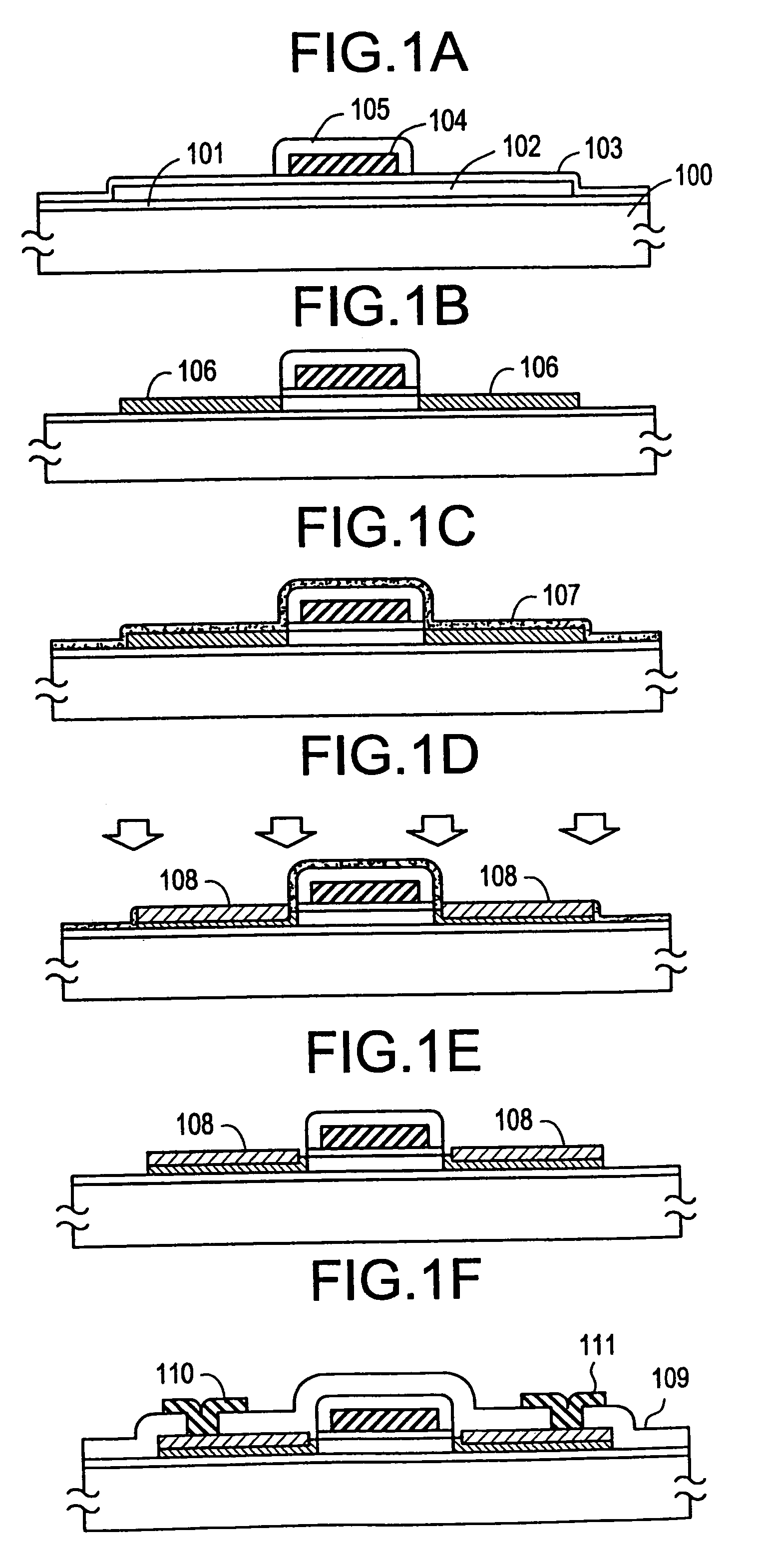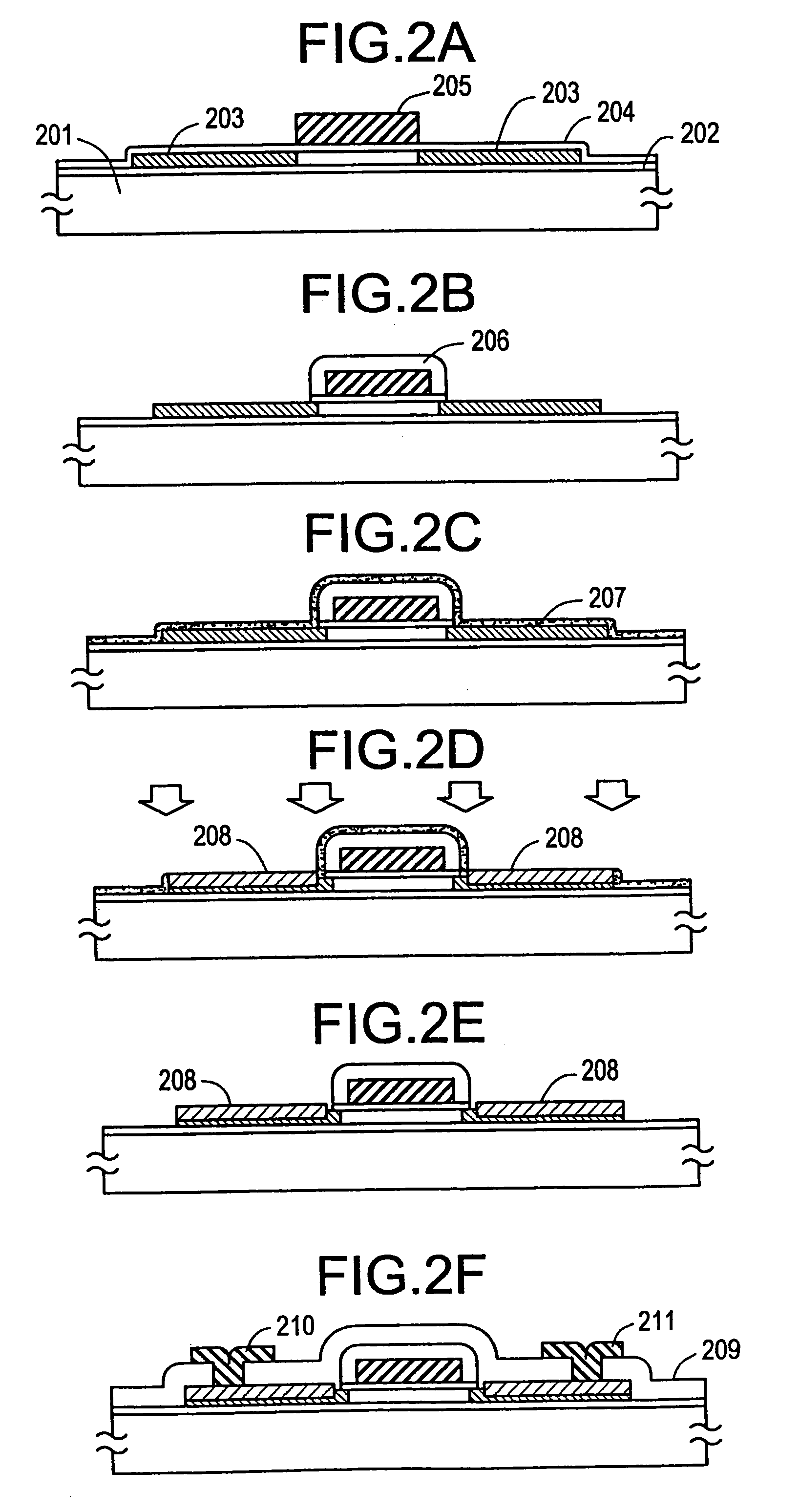Method for manufacturing semiconductor device having metal silicide
a technology of metal silicide and semiconductor devices, which is applied in the direction of semiconductor devices, electrical devices, transistors, etc., can solve the problems of high sheet resistance of source/drain, difficult to lower the sheet resistance, and greatly limited application field, so as to reduce the damage done to the boundary between the channel forming region and the source/drain region, the product yield can be improved, and the sheet resistance of the source/drain is high.
- Summary
- Abstract
- Description
- Claims
- Application Information
AI Technical Summary
Benefits of technology
Problems solved by technology
Method used
Image
Examples
example 1
[0096]Referring to FIG. 1, a process for fabricating a TFT according to an embodiment of the present invention is described below. A 100 to 300 nm thick silicon oxide film 101 was deposited by sputtering in oxygen atmosphere as a base oxide film on a Corning 7059 substrate 100 (300 mm×460 mm in size or 100 mm×100 mm in size). As a process more suited for mass production, however, the base oxide film may be formed by decomposing and depositing TEOS (tetraethoxysilane) using plasma CVD, and annealing the resulting film at a temperature in the range of from 450 to 650° C.
[0097]Then, an amorphous silicon film was deposited by plasma CVD or LPCVD to a thickness of from 30 to 500 nm, preferably from 100 to 300 nm, and was allowed to stand in a reducing atmosphere for 24 hours at a temperature of from 550 to 600° C. to effect crystallization. This step may be performed by laser irradiation. The resulting crystallized silicon film was patterned to give island-like portion 102. A silicon oxi...
example 2
[0105]Referring to FIG. 2, a process for fabricating a TFT according to an embodiment of the present invention is described below. Thus, a base oxide film 202, an island like semiconductor region, and a silicon oxide film which functions as a gate oxide film 204 were formed on a Corning 7059 substrate 100 sequentially in the same manner as in Example 1. Then, a gate contact 205 was formed from an aluminum film from 200 nm to 5 μm in thickness. As shown in FIG. 2(A), an impurity region 203 was formed by implanting impurities using the gate contact as the mask.
[0106]An anodic oxide 206 was then formed around the gate contact (i.e., on the sides and the upper surface of the gate contact) by anodic oxidation in the same manner as that used in Example 1. It should be noted, however, that the impurity region far intrudes into the inner of the anodic oxide as compared to the case of Example 1. Subsequently, the surface of the impurity region was exposed by removing the silicon oxide film e...
example 3
[0109]Referring to FIG. 3, a process for fabricating a TFT according to an embodiment of the present invention is described below. Referring to FIG. 3(A), a base oxide film 301, an island like semiconductor region 302, a silicon oxide film which functions as a gate oxide film 303, and an aluminum film from 200 nm to 5 μm in thickness as a gate contact 304 were formed on a Corning 7059 substrate 300 sequentially in the same manner as in Example 1 above. Then, an anodic oxide 305 was formed on the periphery (the sides and the upper surface) of the gate contact by anodic oxidation following the same procedure as in Example 1.
[0110]Then, the silicon oxide film 303 was removed except for the portion under the contact portion, and a 5 to 50 nm thick platinum (Pt) film 306 was deposited by sputtering to obtain a structure shown in FIG. 3(B). Impurities were introduced through the platinum film by ion doping to obtain an impurity region 307 as shown in FIG. 3(C). Subsequently thereafter, th...
PUM
 Login to View More
Login to View More Abstract
Description
Claims
Application Information
 Login to View More
Login to View More - R&D
- Intellectual Property
- Life Sciences
- Materials
- Tech Scout
- Unparalleled Data Quality
- Higher Quality Content
- 60% Fewer Hallucinations
Browse by: Latest US Patents, China's latest patents, Technical Efficacy Thesaurus, Application Domain, Technology Topic, Popular Technical Reports.
© 2025 PatSnap. All rights reserved.Legal|Privacy policy|Modern Slavery Act Transparency Statement|Sitemap|About US| Contact US: help@patsnap.com



